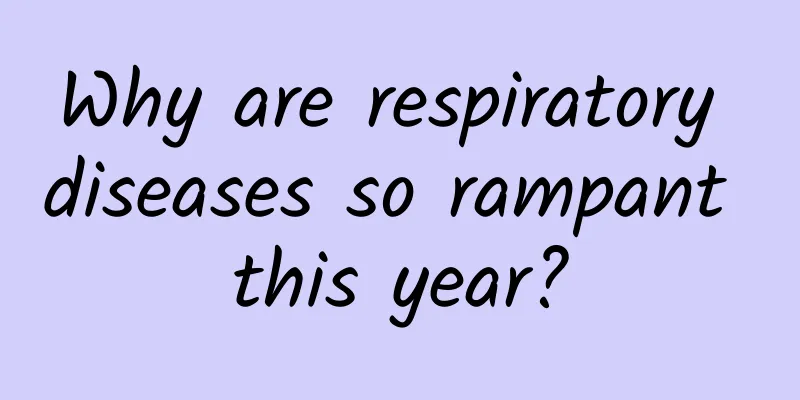Why are respiratory diseases so rampant this year?

|
This year's respiratory infectious diseases are much more severe than in previous years, which is the inevitable result of the three-year lockdown against the COVID-19 pandemic. Based on the rule that the immunity gap increases as the interval between two infections lengthens, we can make plans in advance. Written by Wang Chenguang (PhD in Biology, former professor at Peking Union Medical College) In the first half of this year, I organized two outdoor activities, one on Qingming Festival and the other on May Day. More than 40 people participated in the Qingming Festival. During the event and on the way back, more than half of the netizens showed symptoms of suspected flu. The general reaction was much more uncomfortable than when they were infected with the new coronavirus ("one positive"), and the symptoms were much more severe than when they had the flu in the past. Some people took the new coronavirus antigen test on their own, and the results were all negative. Because no one went for influenza virus testing, it was judged as influenza based on symptoms alone. A total of 29 people participated in the May 1 event, 13 of whom showed mild cold symptoms, and 12 were confirmed to be infected with the new coronavirus. Compared with the Qingming Festival, the symptoms this time were much milder. Local statistics and some people's perceptions are certainly not enough to explain the problem. Large-scale statistics are convincing. European and American countries have already obtained certain statistical data on similar situations to what China encountered in the first half of this year. In the winter of 2022, the COVID-19 prevention and control in Europe and the United States came to an end. Most countries and regions relaxed their epidemic prevention and control policies, and economic activities and people's lives gradually returned to the pre-epidemic state. However, at this time, pediatric hospitals in the United States and Canada found that the number of children infected with respiratory syncytial virus (RSV) surged, from the infection level lower than in previous years during the COVID-19 pandemic to far higher than the average level in previous years, and even caused a continuous shortage of children's antipyretic and analgesic drugs. At the same time, influenza is also spreading widely, and the flu season is coming earlier than in previous years. Now (after entering autumn), respiratory mycoplasma infections have also begun to show local outbreaks in mainland China. Many doctors are reporting that respiratory infectious diseases this year are indeed more rampant than in previous years. Why are there so many children with infectious respiratory diseases? Is it a coincidence or a necessity after the COVID-19 pandemic? Why did the flu, which was once commonplace, suddenly become so severe? And why did the COVID-19, which has made the Chinese nervous for three years and caused countless "slash throats" when it was relaxed at the end of last year, suddenly become so mild? The answers to this series of questions are all related to one term: immunity gap. So far, the immunity gap is not a strict scientific concept. It is a concept that emerged to facilitate the description of the characteristics of the spread of infectious diseases and to facilitate the understanding of the characteristics of the epidemic of infectious diseases in the post-COVID-19 period. When a new virus comes out and no one is immune to it, the virus has the strongest ability to spread. We might as well set the population immunity level at this time to 0. As the virus spreads, some people with underlying diseases and immune deficiencies die, and those who recover from the infection become immune to the virus. Assuming that everyone is infected and all those who survive develop immune resistance to the virus, the population immunity level is 100. The difference between any intermediate number and 100 is the immunity gap. Last summer, American scientists began using this concept to predict outbreaks of RSV and other seasonal respiratory viruses that year, and it was eventually verified. RSV and influenza cases dropped to very low levels during the 2019-2020 peak season (winter, which coincided with the initial stage of the COVID-19 pandemic), much lower than the same period in previous years. This is not difficult to understand: the medium for the spread of respiratory infectious diseases is people participating in social activities, and the COVID-19 control measures include maintaining social distance, wearing masks, and widespread lockdowns. Schools in many areas are closed, students take online classes, and most staff work from home except for essential positions. These measures effectively reduce contact between people and cut off the chain of virus transmission. However, the social nature of human beings determines that epidemic lockdowns cannot last forever. Once the lockdown is lifted and normal social activities resume, the chain of infectious disease transmission will naturally be rebuilt. For some infectious diseases, the lack of infection opportunities is not a good thing for humans and will have a negative impact on the entire population - because the immunity gap will increase as the infection interval lengthens. After a person is infected with a virus, the antibodies in the immune system will decline quickly and are usually only effective during one epidemic season. Measures to prevent the new coronavirus have led to a significant decrease in the number of cases of respiratory infections other than the new coronavirus. The reduced exposure to these viruses has caused a decrease in natural immunity levels, in other words, the immunity gap has widened. After a longer period of lack of infection opportunities, the immune barrier of the population has become fragile, and the protection of vulnerable groups has been insufficient. When strict new coronavirus protection measures are lifted, these viruses will spread again and infect vulnerable people and those who have not been exposed to these pathogens, causing more infections in infants, children and adults than before. This has been partially verified by real data. In the 2022-2023 flu season, after three years of epidemic control, approximately 100,000 to 200,000 people in the United States were hospitalized due to RSV infection, and the number of deaths from RSV infection was between 6,000 and 10,000, which is much higher than the level in the years before the new crown pandemic (exceeding the full-year data before the epidemic). In other words, the outbreak of RSV infection among children in North America at the end of 2022 and the recent epidemic of respiratory diseases in China should be inevitable phenomena after the end of the new crown pandemic. So, how do we fill the “immunity gap”? First, return to normal economic and social life as soon as possible when conditions permit. The spread of some non-high-risk pathogens is not always a bad thing. Since it cannot be avoided, the infection of low-risk groups is helpful in building a herd immunity barrier, even if it is a passive and last resort. Second, take preventive measures, such as effective vaccination. Vaccination of high-risk groups can reduce the risk of severe illness and death, while vaccination of low-risk groups can effectively establish an immune barrier and reduce the spread of the virus. Third, based on the understanding that the immunity gap will increase as the interval between two infections increases, make corresponding plans, including necessary drug reserves. The concept of immunity gap applies not only to viruses such as influenza and RSV, but also to the new coronavirus. China has adopted stricter lockdown measures than other countries during the COVID-19 pandemic. Especially after most countries and regions in the world have relaxed control in 2022, the overall immunity level of people living on the mainland against the new coronavirus has become increasingly different from that in other parts of the world. Drawing on the experience of North America, we can expect that as the immunity formed by the full outbreak of the new coronavirus at the end of last year gradually fades, the new coronavirus infection will show cyclical outbreaks. This year's "May 1st" holiday is evidence that many people experienced a second infection. Combined with the law of weakening antibodies after new coronavirus infection, November is likely to enter the next outbreak period. Unlike other countries and regions in the world, the outbreak in China at the end of last year was concentrated in about a month, so the next outbreak will also show this trend. Although the overall harm of the outbreak is gradually weakening, the high number of cases in the short term may still lead to a shortage of medical resources. For this reason, as winter approaches, the author recommends that patients with underlying diseases and the elderly take protective measures, including timely influenza vaccination, stockpiling anti-new coronavirus drugs and antipyretic and analgesic drugs such as ibuprofen. This article is supported by the Science Popularization China Starry Sky Project Produced by: China Association for Science and Technology Department of Science Popularization Producer: China Science and Technology Press Co., Ltd., Beijing Zhongke Xinghe Culture Media Co., Ltd. Special Tips 1. Go to the "Featured Column" at the bottom of the menu of the "Fanpu" WeChat public account to read a series of popular science articles on different topics. 2. Fanpu provides a function to search articles by month. Follow the official account and reply with the four-digit year + month, such as "1903", to get the article index for March 2019, and so on. Copyright statement: Personal forwarding is welcome. Any form of media or organization is not allowed to reprint or excerpt without authorization. For reprint authorization, please contact the backstage of the "Fanpu" WeChat public account. |
Recommend
What can UCloud do to accelerate Chinese companies’ overseas expansion?
The original intention of globalization strategy ...
Double 11 is marketing, not promotion
Tmall Double 11 just ended, generating sales of 4...
From community to e-commerce, how did Xiaohongshu become popular?
Since its establishment in June 2013, Xiaohongshu...
Are these 9.9 yuan free shipping headphones really usable? Will they damage your hearing?
On many shopping apps, when you search for "...
How to optimize old SEM accounts? How to optimize Baidu promotion account?
For friends who do bidding, many will encounter t...
First confirmed! There is a source of life outside the Earth! Are there really aliens?
Expert of this article: Yang Chao, PhD in Chemist...
The temperature drops suddenly, rain and snow come, how powerful is this all-round cold air?
From January 11 to 15, an all-around cold front w...
Regarding private tea tasting in Nanjing, this one in Jiangning District is very real
Nanjing tea drinking resource reservation, privat...
Volkswagen and Mobileye sign cooperation agreement to develop autonomous driving
According to foreign media reports, Volkswagen Gr...
The elements of the inflatable ball control the life and death of the universe | Tutu Science Fiction
Your browser does not support the video tag Vocab...
Children have a fever, can rubbing alcohol reduce the fever? Don't, these fever-reducing methods may be fatal
gossip "Children with fever can be treated w...
Can you predict people’s first impression of you by looking at your photo for the first time?
This article comes from: Big Data Digest Everyone...
What will life be like for someone whose kidneys are broken?
In recent times, topics related to Thailand touri...
Following the light: He uses "photon imaging" to illuminate the biological world!
Fireflies are always an indispensable part of sum...
To control fatty liver, should we eat less staple food or less meat?
A friend told me that he was only in his early fo...









